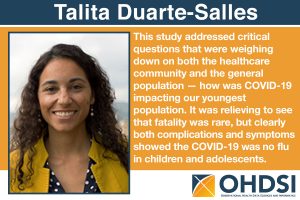- Who We Are
- Updates & News
- Standards
- Software Tools
- Network Studies
- Community Forums
- Education
- New To OHDSI?
- Community Calls
- Past Events
- 2024 Europe Symposium
- 2024 Thailand Tutorial
- 2024 Japan Tutorial
- 2024 DevCon
- 2024 Phenotype Phebruary
- 2023 Global Symposium
- 2023 APAC Symposium
- 2023 Europe Symposium
- 2023 SOS Challenge
- 2023 DevCon
- 2023 Phenotype Phebruary
- 2022 Global Symposium
- 2021 Global Symposium
- 2020 Global Symposium
- ALL Past OHDSI Events
- Workgroups
- 2023 ‘Our Journey’ Annual Report
- This Week In OHDSI
- Support & Sponsorship
- CBER Best Seminars
- 2024 Europe Symposium
- 2024 Global Symposium
- Github
- YouTube
- Newsletters
COVID-19 Shows Greater Complications In Youth Than Influenza, Though Fatality Is Rare
 While fatality was fortunately rare, complications including hospitalization, hypoxemia and pneumonia were more frequent in children and adolescents either diagnosed or hospitalized with COVID-19 than with seasonal influenza. Furthermore, labored breathing, loss of smell and gastrointestinal issues were more prevalent symptoms for younger people inflicted with COVID-19 than with influenza.
While fatality was fortunately rare, complications including hospitalization, hypoxemia and pneumonia were more frequent in children and adolescents either diagnosed or hospitalized with COVID-19 than with seasonal influenza. Furthermore, labored breathing, loss of smell and gastrointestinal issues were more prevalent symptoms for younger people inflicted with COVID-19 than with influenza.
These findings, along with that of significant treatment heterogeneity for children/adolescents hospitalized with COVID-19, were presented in the study “30-day outcomes of Children and Adolescents with COVID-19: An International Experience,” published May 28 by Pediatrics.
Early in the pandemic, opinions around the COVID-19 impact on children and adolescents ranged from it being no more than the common flu to fear of its potential impact on lesser-developed immune systems. This OHDSI global network study compared the real-world observational data of more than 242,000 children/adolescents diagnosed and nearly 10,000 hospitalized with COVID-19 to more than 2,000,000 diagnosed with influenza across five countries (France, Germany, South Korea, Spain, United States) to provide a clearer picture of its impact.
Asthma and obesity were the most common baseline comorbidities — a common finding in disease prevalence among a general pediatric population — in the studied databases, but there was a higher prevalence of rare conditions, including congenital malformation/s, neurodevelopmental disorders, and heart disease, among those hospitalized with COVID-19. Pediatric patients with COVID-19 also showed higher rates of labored breathing, loss of smell and gastrointestinal symptoms than those presenting with influenza, which could help improve early diagnosis of COVID-19 among this population.
Adjunctive therapies were the most common treatment options in children/adolescents, though there was global heterogeneity on which particular therapies were used (systemic corticosteroids and famotidine were most common). The most common 30-day complications for hospitalized children/adolescents with COVID-19 were hypoxemia and pneumonia, both of which occurred at a higher rate than hospitalized influenza patients.
There was limited knowledge of the COVID-19 impact on children/adolescents around the world during the first half of 2020, when the OHDSI community collaborated on the CHARYBDIS Project. Findings at the time ranged from a 5.7 % hospitalization rate to another that reported a 63% hospitalization rate. There was a need for reliable evidence on the demographics, comorbidities, symptoms, in-hospital treatments, and health outcomes among children/adolescents to inform clinical decision-making.
“This study addressed critical questions that were weighing down on both the healthcare community and the general population — how was COVID-19 impacting our youngest population,” said study lead Talita Duarte-Salles, PhD, an epidemiologist at IDIAP Jordi Gol. “While some claimed that COVID-19 was no different than the flu early last year, the real-world evidence we generated through open science showed something quite different. It was relieving to see that fatality was rare, but clearly both complications and symptoms showed the COVID-19 was no flu in children and adolescents.”
The study was developed and executed by the OHDSI (Observational Health Data Sciences and Informatics) community, a multi-stakeholder, interdisciplinary network that collaborates globally to bring out the value of health data through open science and large-scale analytics. This study resulted from the CHARYBDIS Project, which set out to:
1) Describe the baseline demographics, clinical characteristics, treatments, symptoms and outcomes of interest among individuals with COVID-19 overall and stratified by sex, age and specific comorbidities
2) Describe characteristics and outcomes of influenza patients between September 2017 and April 2018 compared to the COVID-19 population
This project has resulted in several published studies, including ones on general COVID-19 phenotyping, patients with autoimmune disease, and use of repurposed and adjunctive drug therapies. Several others are undergoing peer review and have been posted to a preprint server; OHDSI’s work on COVID-19 can be found here.
“Generating reliable evidence that can inform clinical decision-making for children and adolescents was so important, and it doesn’t happen without collaboration and the foundation of open-source tools and practices developed for years in this network,” Duarte-Salles said. “It was truly inspiring the way our OHDSI community rallied together globally in the face of this unprecedented pandemic and collaborated together.”
